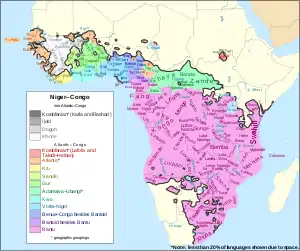Atlantic–Congo languages
The Atlantic–Congo languages are a major division constituting the core of the Niger–Congo language family of Africa, characterised by the noun class systems typical of the family. They comprise all of Niger–Congo except Mande, Dogon, Ijoid and the Katla and Rashad languages (previously classified as Kordofanian). Mukarovsky's West-Nigritic corresponded roughly to modern Atlantic–Congo.
| Atlantic–Congo | |
|---|---|
| Geographic distribution | Africa |
| Linguistic classification | Niger–Congo
|
| Subdivisions | |
| ISO 639-5 | alv |
| Glottolog | atla1278 |
 The Atlantic–Congo languages shown within the Niger–Congo language family. Non-Atlantic–Congo languages are greyscale. | |
In the infobox at the right, the languages which appear to be the most divergent are placed at the top.[1] The Atlantic branch is defined in the narrow sense, while the former Atlantic branches Mel and the isolates Sua, Gola and Limba, are split out as primary branches; they are mentioned next to each other because there is no published evidence to move them; Volta–Congo is intact apart from Senufo and Kru.
In addition, Güldemann (2018) lists Nalu and Rio Nunez as unclassified languages within Niger-Congo.[2]
There are a few poorly attested languages, such as Bayot and Bung, which may prove to be additional branches.
References
- Roger Blench, Niger-Congo: an alternative view
- Güldemann, Tom (2018). "Historical linguistics and genealogical language classification in Africa". In Güldemann, Tom (ed.). The Languages and Linguistics of Africa. The World of Linguistics series. 11. Berlin: De Gruyter Mouton. pp. 58–444. doi:10.1515/9783110421668-002. ISBN 978-3-11-042606-9.